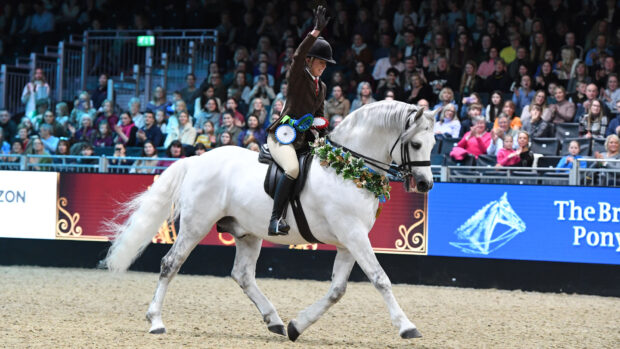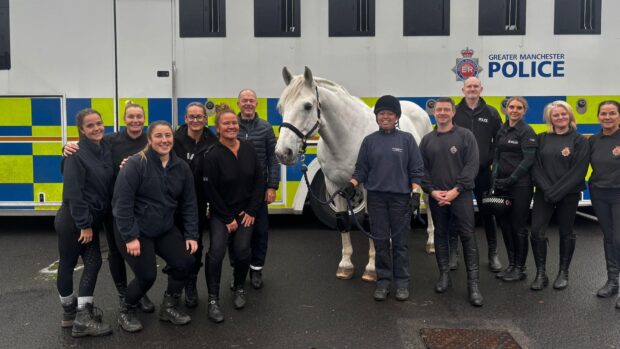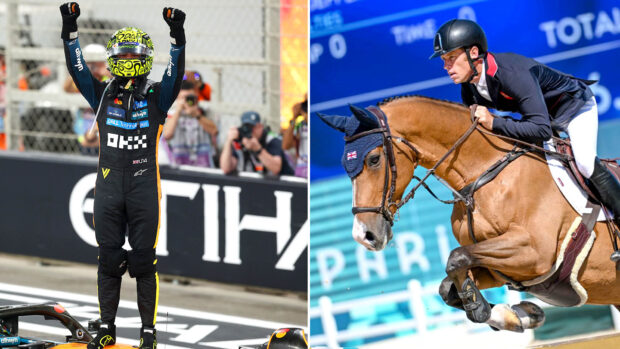Without the pressure of high profile competitive outings on the immediate horizon, winter provides the perfect opportunity to hunker down and get some working hunter pony training hours in the bag. While the off-season provides a chance to take a break, if you have ambitions of jumping any of the circuit’s most challenging rustic courses this year, then you’ll need a training plan in place. With up-to-height fences, challenging lines and spooky obstacles to tackle, riders need to do their homework if they want to mix it with the best in working hunter pony classes.
Training for working hunter pony classes requires a three-pronged approach. As well as a fault-free and stylish jumping round, combinations must then perform an equally impressive show on the flat, before the pony is presented for the conformation phase.
Under British Show Pony Society (BSPS) rules, working hunter classes are scored out of a total 100 marks. During phase one, 50 marks are awarded for a clear jumping round, with 10 points being deducted for a knock down, 15 for a first refusal and 20 for a second refusal. A third refusal results in disqualification. A total of 20 marks are then awarded for style and manners while jumping. In the second phase, 20 marks are on offer for manners and way of going during the indvidual show, and 10 for conformation, type and freedom of action.
Success in working hunter pony classes does not just come from a clear round, as in showjumping; style during the jump phase is essential and ponies must then retain their manners and way of going on the flat, which can be a challenge for some.
Working hunter pony training: common problems
H&H chats to some of the showing world’s most consistent working hunter pony riders and producers to gather training tips designed to solve some of the most common problems seen so you can ensure your winter programme is finely tuned ahead of the upcoming season.
{"content":"PHA+R2VvcmdpYSBEYXJsaW5ndG9uIGlzIGEgbGVhZGluZyB3b3JraW5nIGh1bnRlciBwb255IHJpZGVyIHdobyBoYXMgd29uIGF0IDxhIGhyZWY9Ii9ob3lzIj5Ib3JzZSBvZiB0aGUgWWVhciBTaG93IChIT1lTKTwvYT4gYW5kIHRoZSA8YSBocmVmPSIvcm95YWwtaW50ZXJuYXRpb25hbC1ob3JzZS1zaG93Ij5Sb3lhbCBJbnRlcm5hdGlvbmFsIEhvcnNlIFNob3cgKFJJSFMpPC9hPiBvbiBtdWx0aXBsZSBvY2Nhc2lvbnMuIFNoZSB3YXMgTSZhbXA7TSB3b3JraW5nIGh1bnRlciBwb255IGNoYW1waW9uIGF0IEhPWVMgaW4gMjAxNSBvbiBUeW53eWRkIEdvb2QgRnJpZGF5IChTbWFydGllKSBhbmQgc2hlIGFsc28gd29uIHRoZSBpbnRlcm1lZGlhdGUgZmluYWwgdGhlcmUgaW4gMjAyMiBvbiBKYXJhLiBTaGUgaGFzIGFsc28gd29uIHRoZSBSSUhTIHR3aWNlIGFzIHdlbGwgYXMgbXVsdGlwbGUgQlNQUyBhbmQgY291bnR5IHNob3cgY2hhbXBpb25zaGlwcy48L3A+CjxoMz4xLiBCdWxsZmluY2hlczwvaDM+CjxwPuKAnElmIGEgcG9ueSBpcyBnb2luZyB0byBiZSBzcG9va3ksIGl04oCZcyB1c3VhbGx5IGF0IGEgd2F0ZXIgdHJheSBvciBhIGJ1bGxmaW5jaCzigJ0gR2VvcmdpYSBleHBsYWlucy4g4oCcQSBidWxsZmluY2ggY2FuIGNhdXNlIHRyb3VibGUgaWYgeW914oCZcmUgb24gYSBwYXJ0aWN1bGFybHkgY2FyZWZ1bCBob3JzZSBhcyB0aGV5IHRoaW5rIHRoZXkgbXVzdCBnbyBvdmVyIHRoZSB0b3Agb2YgaXQuIFRoZXkgd2lsbCBvZnRlbiBqdW1wIGl0IHRvbyBiaWcgZmlyc3QgdGltZSBhbmQgd29ycnkgdGhlbXNlbHZlcywgb3IgdGhleSBzaW1wbHkgZG9u4oCZdCB1bmRlcnN0YW5kIHdoYXQgeW914oCZcmUgYXNraW5nIG9mIHRoZW0gZnJvbSB0aGUgb2ZmLjwvcD4KPHA+PGRpdiBpZD0iYXR0YWNobWVudF84ODEyMzQiIHN0eWxlPSJ3aWR0aDogMTQxMHB4IiBjbGFzcz0id3AtY2FwdGlvbiBhbGlnbm5vbmUiPjxpbWcgZmV0Y2hwcmlvcml0eT0iaGlnaCIgZGVjb2Rpbmc9ImFzeW5jIiBhcmlhLWRlc2NyaWJlZGJ5PSJjYXB0aW9uLWF0dGFjaG1lbnQtODgxMjM0IiBjbGFzcz0ibGF6eWxvYWQgYmx1ci11cCBzaXplLWZ1bGwgd3AtaW1hZ2UtODgxMjM0IiBkYXRhLXByb2Nlc3NlZCBzcmM9Imh0dHBzOi8va2V5YXNzZXRzLnRpbWVpbmN1ay5uZXQvaW5zcGlyZXdwL2xpdmUvd3AtY29udGVudC91cGxvYWRzL3NpdGVzLzE0LzIwMTcvMDMvbmV3LWhoLXBsYWNlaG9sZGVyLTIwMHgyMDAucG5nIiBkYXRhLXNyYz0iaHR0cHM6Ly9rZXlhc3NldHMudGltZWluY3VrLm5ldC9pbnNwaXJld3AvbGl2ZS93cC1jb250ZW50L3VwbG9hZHMvc2l0ZXMvMTQvMjAyNS8wMS9idWxsZmluY2hCU1BTLUNoYW1wcy4tMTYuMDQuMTcyODY5Ml83NzIyMjQ0Ml8xNzk0MTcxMDIuanBnIiBhbHQ9IldvcmtpbmcgaHVudGVyIHBvbnkgdHJhaW5pbmc6IGEgZ3JleSBwb255IGp1bXBpbmcgYSBidWxsZmluY2ggYXQgYSBzaG93IiB3aWR0aD0iMTQwMCIgaGVpZ2h0PSI3ODgiIGRhdGEtc2l6ZXM9ImF1dG8iIGRhdGEtc3Jjc2V0PSJodHRwczovL2tleWFzc2V0cy50aW1laW5jdWsubmV0L2luc3BpcmV3cC9saXZlL3dwLWNvbnRlbnQvdXBsb2Fkcy9zaXRlcy8xNC8yMDI1LzAxL2J1bGxmaW5jaEJTUFMtQ2hhbXBzLi0xNi4wNC4xNzI4NjkyXzc3MjIyNDQyXzE3OTQxNzEwMi5qcGcgMTQwMHcsIGh0dHBzOi8va2V5YXNzZXRzLnRpbWVpbmN1ay5uZXQvaW5zcGlyZXdwL2xpdmUvd3AtY29udGVudC91cGxvYWRzL3NpdGVzLzE0LzIwMjUvMDEvYnVsbGZpbmNoQlNQUy1DaGFtcHMuLTE2LjA0LjE3Mjg2OTJfNzcyMjI0NDJfMTc5NDE3MTAyLTMwMHgxNjkuanBnIDMwMHcsIGh0dHBzOi8va2V5YXNzZXRzLnRpbWVpbmN1ay5uZXQvaW5zcGlyZXdwL2xpdmUvd3AtY29udGVudC91cGxvYWRzL3NpdGVzLzE0LzIwMjUvMDEvYnVsbGZpbmNoQlNQUy1DaGFtcHMuLTE2LjA0LjE3Mjg2OTJfNzcyMjI0NDJfMTc5NDE3MTAyLTYzMHgzNTUuanBnIDYzMHcsIGh0dHBzOi8va2V5YXNzZXRzLnRpbWVpbmN1ay5uZXQvaW5zcGlyZXdwL2xpdmUvd3AtY29udGVudC91cGxvYWRzL3NpdGVzLzE0LzIwMjUvMDEvYnVsbGZpbmNoQlNQUy1DaGFtcHMuLTE2LjA0LjE3Mjg2OTJfNzcyMjI0NDJfMTc5NDE3MTAyLTEzNXg3Ni5qcGcgMTM1dywgaHR0cHM6Ly9rZXlhc3NldHMudGltZWluY3VrLm5ldC9pbnNwaXJld3AvbGl2ZS93cC1jb250ZW50L3VwbG9hZHMvc2l0ZXMvMTQvMjAyNS8wMS9idWxsZmluY2hCU1BTLUNoYW1wcy4tMTYuMDQuMTcyODY5Ml83NzIyMjQ0Ml8xNzk0MTcxMDItMzIweDE4MC5qcGcgMzIwdywgaHR0cHM6Ly9rZXlhc3NldHMudGltZWluY3VrLm5ldC9pbnNwaXJld3AvbGl2ZS93cC1jb250ZW50L3VwbG9hZHMvc2l0ZXMvMTQvMjAyNS8wMS9idWxsZmluY2hCU1BTLUNoYW1wcy4tMTYuMDQuMTcyODY5Ml83NzIyMjQ0Ml8xNzk0MTcxMDItNjIweDM0OS5qcGcgNjIwdywgaHR0cHM6Ly9rZXlhc3NldHMudGltZWluY3VrLm5ldC9pbnNwaXJld3AvbGl2ZS93cC1jb250ZW50L3VwbG9hZHMvc2l0ZXMvMTQvMjAyNS8wMS9idWxsZmluY2hCU1BTLUNoYW1wcy4tMTYuMDQuMTcyODY5Ml83NzIyMjQ0Ml8xNzk0MTcxMDItOTIweDUxOC5qcGcgOTIwdywgaHR0cHM6Ly9rZXlhc3NldHMudGltZWluY3VrLm5ldC9pbnNwaXJld3AvbGl2ZS93cC1jb250ZW50L3VwbG9hZHMvc2l0ZXMvMTQvMjAyNS8wMS9idWxsZmluY2hCU1BTLUNoYW1wcy4tMTYuMDQuMTcyODY5Ml83NzIyMjQ0Ml8xNzk0MTcxMDItMTIyMHg2ODcuanBnIDEyMjB3IiBzaXplcz0iKG1heC13aWR0aDogMTQwMHB4KSAxMDB2dywgMTQwMHB4IiAvPjxwIGlkPSJjYXB0aW9uLWF0dGFjaG1lbnQtODgxMjM0IiBjbGFzcz0id3AtY2FwdGlvbi10ZXh0Ij5UaGUgYWltIGlzIHRvIGp1bXAgdGhyb3VnaCBhbmQgbm90IHJpZ2h0IG92ZXIgdGhlIGJ1bGxmaW5jaC4gQ3JlZGl0OiBUcmV2b3IgTWVla3MgUGhvdG9ncmFwaHk8L3A+PC9kaXY+PGJyIC8+CjwvcD4KPHA+4oCcQXQgaG9tZSwgSSB3b3VsZCBzdGFydCBieSBvcGVuaW5nIHRoZSBicnVzaGVzIHVwIHJlYWxseSB3aWRlIG9uIGVhY2ggc2lkZSBvZiB0aGUganVtcCBzbyB0aGUgaG9yc2UgY2FuIHNlZSB0aGVpciB3YXkgdGhyb3VnaCB0aGUgbWlkZGxlLCBncmFkdWFsbHkgbW92aW5nIHRoZW0gaW4gZWFjaCB0aW1lIHRoZXkgZ28gb3ZlciBpdC4gVGhlbiwgSeKAmWQgZml4IHRoZSBicnVzaGVzIHNvIHRoZXkgZ2VudGx5IHNraW0gdGhlIHVuZGVybmVhdGggb2YgdGhlIGhvcnNlLiBJ4oCZZCB3b3JrIGl0IHVwIHVudGlsIHRoZXnigJlyZSBjb25maWRlbnRseSBqdW1waW5nIGEgZnVsbCBidWxsZmluY2guPC9wPgo8cD7igJxJ4oCZdmUgaGFkIGEgZmV3IHBvbmllcyB3aG8gYWx3YXlzIHdhbnRlZCB0byBqdW1wIG92ZXIgdGhlIHRvcCBvZiBhIGJ1bGxmaW5jaC4gQm90aCBTbWFydGllIGFuZCBKYXJhIHdvdWxkIGxlYXAgaXQgYXMgdGhleSBhcmUgc3VjaCBjYXJlZnVsIGp1bXBlcnMuIFRob3VnaCBvbmNlIHRoZXkga25ldyB0aGVyZSB3YXMgYSBwYXRoIHRocm91Z2gsIHRoZXJlIHdhcyBubyBwcm9ibGVtLuKAnTwvcD4KCjxoMz4yLiBXYXRlciB0cmF5czwvaDM+CjxwPkEgd2F0ZXIgdHJheSBpcyBvZnRlbiB0aGUgYm9nZXkgZmVuY2Ugb2YgdGhlIGNvdXJzZSBhbmQsIGFzIEdlb3JnaWEgZXhwbGFpbnMsIHNvbWUgaG9yc2VzIG5ldmVyIGJlY29tZSBmdWxseSBjb25maWRlbnQgd2l0aCB0aGVtLiBUaGlzIHNob3VsZCBiZSBhIGtleSBwYXJ0IG9mIHRyYWluaW5nIGZvciB3b3JraW5nIGh1bnRlciBwb255IGNsYXNzZXMuPC9wPgo8cD48ZGl2IGlkPSJhdHRhY2htZW50Xzg4MTI2NSIgc3R5bGU9IndpZHRoOiAxNDEwcHgiIGNsYXNzPSJ3cC1jYXB0aW9uIGFsaWdubm9uZSI+PGltZyBkZWNvZGluZz0iYXN5bmMiIGFyaWEtZGVzY3JpYmVkYnk9ImNhcHRpb24tYXR0YWNobWVudC04ODEyNjUiIGNsYXNzPSJsYXp5bG9hZCBibHVyLXVwIHdwLWltYWdlLTg4MTI2NSBzaXplLWZ1bGwiIGRhdGEtcHJvY2Vzc2VkIHNyYz0iaHR0cHM6Ly9rZXlhc3NldHMudGltZWluY3VrLm5ldC9pbnNwaXJld3AvbGl2ZS93cC1jb250ZW50L3VwbG9hZHMvc2l0ZXMvMTQvMjAxNy8wMy9uZXctaGgtcGxhY2Vob2xkZXItMjAweDIwMC5wbmciIGRhdGEtc3JjPSJodHRwczovL2tleWFzc2V0cy50aW1laW5jdWsubmV0L2luc3BpcmV3cC9saXZlL3dwLWNvbnRlbnQvdXBsb2Fkcy9zaXRlcy8xNC8yMDI1LzAxL0hIX0FMSUNFX0hPTUVSX0FUX0hPTUUtNTMyMS5qcGciIGFsdD0iY2hlc3RudXQgcG9ueSBqdW1waW5nIHdhdGVyIHRyYXkiIHdpZHRoPSIxNDAwIiBoZWlnaHQ9Ijc4OCIgZGF0YS1zaXplcz0iYXV0byIgZGF0YS1zcmNzZXQ9Imh0dHBzOi8va2V5YXNzZXRzLnRpbWVpbmN1ay5uZXQvaW5zcGlyZXdwL2xpdmUvd3AtY29udGVudC91cGxvYWRzL3NpdGVzLzE0LzIwMjUvMDEvSEhfQUxJQ0VfSE9NRVJfQVRfSE9NRS01MzIxLmpwZyAxNDAwdywgaHR0cHM6Ly9rZXlhc3NldHMudGltZWluY3VrLm5ldC9pbnNwaXJld3AvbGl2ZS93cC1jb250ZW50L3VwbG9hZHMvc2l0ZXMvMTQvMjAyNS8wMS9ISF9BTElDRV9IT01FUl9BVF9IT01FLTUzMjEtMzAweDE2OS5qcGcgMzAwdywgaHR0cHM6Ly9rZXlhc3NldHMudGltZWluY3VrLm5ldC9pbnNwaXJld3AvbGl2ZS93cC1jb250ZW50L3VwbG9hZHMvc2l0ZXMvMTQvMjAyNS8wMS9ISF9BTElDRV9IT01FUl9BVF9IT01FLTUzMjEtNjMweDM1NS5qcGcgNjMwdywgaHR0cHM6Ly9rZXlhc3NldHMudGltZWluY3VrLm5ldC9pbnNwaXJld3AvbGl2ZS93cC1jb250ZW50L3VwbG9hZHMvc2l0ZXMvMTQvMjAyNS8wMS9ISF9BTElDRV9IT01FUl9BVF9IT01FLTUzMjEtMTM1eDc2LmpwZyAxMzV3LCBodHRwczovL2tleWFzc2V0cy50aW1laW5jdWsubmV0L2luc3BpcmV3cC9saXZlL3dwLWNvbnRlbnQvdXBsb2Fkcy9zaXRlcy8xNC8yMDI1LzAxL0hIX0FMSUNFX0hPTUVSX0FUX0hPTUUtNTMyMS0zMjB4MTgwLmpwZyAzMjB3LCBodHRwczovL2tleWFzc2V0cy50aW1laW5jdWsubmV0L2luc3BpcmV3cC9saXZlL3dwLWNvbnRlbnQvdXBsb2Fkcy9zaXRlcy8xNC8yMDI1LzAxL0hIX0FMSUNFX0hPTUVSX0FUX0hPTUUtNTMyMS02MjB4MzQ5LmpwZyA2MjB3LCBodHRwczovL2tleWFzc2V0cy50aW1laW5jdWsubmV0L2luc3BpcmV3cC9saXZlL3dwLWNvbnRlbnQvdXBsb2Fkcy9zaXRlcy8xNC8yMDI1LzAxL0hIX0FMSUNFX0hPTUVSX0FUX0hPTUUtNTMyMS05MjB4NTE4LmpwZyA5MjB3LCBodHRwczovL2tleWFzc2V0cy50aW1laW5jdWsubmV0L2luc3BpcmV3cC9saXZlL3dwLWNvbnRlbnQvdXBsb2Fkcy9zaXRlcy8xNC8yMDI1LzAxL0hIX0FMSUNFX0hPTUVSX0FUX0hPTUUtNTMyMS0xMjIweDY4Ny5qcGcgMTIyMHciIHNpemVzPSIobWF4LXdpZHRoOiAxNDAwcHgpIDEwMHZ3LCAxNDAwcHgiIC8+PHAgaWQ9ImNhcHRpb24tYXR0YWNobWVudC04ODEyNjUiIGNsYXNzPSJ3cC1jYXB0aW9uLXRleHQiPkp1bXAgYXMgbWFueSB3YXRlciB0cmF5cyBhcyB5b3UgY2FuIGF0IGhvbWUsIG9yIGFsbCBzaXplcyBhbmQgc2hhcGVzLiBDcmVkaXQ6IEpvbiBTdHJvdWQgTWVkaWE8L3A+PC9kaXY+PGJyIC8+CjwvcD4KPHA+4oCcTXkgd29ya2VyIExpc2HigJlzIERyZWFtIGNhbiBiZSBjaGVla3kgd2l0aCB0aGVtLCBhbmQgSSBjYW4gc3RpbGwgbmV2ZXIgY29tcGxldGVseSB0cnVzdCBoZXIgd2l0aCBvbmUsIGV2ZW4gYXQgMTggeWVhcnMgb2xkLOKAnSBzaGUgc2F5cy4g4oCcU29tZSBuZXZlciBnZXQgYmV0dGVyIGFuZCB5b3UgbXVzdCBhbHdheXMgYmUgcmVhZHkgZm9yIHRoZW0gdG8gc3Bvb2sgaW4gdGhlIHJpbmcsIHRob3VnaCB5b3UgY2FuIHB1dCB0aGUgcHJhY3RpY2UgaW4gYXQgaG9tZS4gQmVmb3JlIGV2ZXJ5IHNpbmdsZSBzaG93LCBMaXNhIHdpbGwganVtcCBhIHdhdGVyIHRyYXkgdGhlIGRheSBiZWZvcmUsIGFuZCB3aGVuIEkgZmlyc3QgZ28gaW50byB0aGUgcmluZyB0byBqdW1wLCBJIHdpbGwgdHJvdCBwYXN0IHRoZSB3YXRlciB0cmF5IHNvIHNoZSBjYW4gc2VlIGl0IGFuZCBrbm93cyBpdOKAmXMgdGhlcmUuPC9wPgo8cD7igJxXaGVuIHRyYWluaW5nLCBpdOKAmXMgaW1wb3J0YW50IHRvIHRyeSBhbmQganVtcCBhcyBtYW55IHdhdGVyIHRyYXlzIGFzIHlvdSBjYW4sIG9mIGFsbCBzaXplcyBhbmQgc2hhcGVzLiBBdCBob21lLCB3ZSBoYXZlIGEgd2F0ZXIgdHJheSB3aGljaCBpcyBtYWRlIHVwIG9mIGZvdXIgc2VwYXJhdGUgc3F1YXJlcywgbWVhbmluZyB5b3UgY2FuIHN0YXJ0IHdpdGggdHdvIHNxdWFyZXMgdW5kZXIgdGhlIGp1bXAgYnV0IHB1bGxlZCBhcGFydCBzbyB0aGUgaG9yc2UgY2FuIGdvIHRocm91Z2ggdGhlIGdhcCBpbiB0aGUgbWlkZGxlLiBUaGVuLCB3ZeKAmWQgcHV0IGEgcG9sZSBvdmVyIHRoZSB0b3Agc28gdGhlIGhvcnNlIHBvcHMgdGhlIGdhcCBidXQgb3ZlciBzb21ldGhpbmcuIFlvdSBjYW4gYnVpbGQgaXQgdXAgdG8gcHV0dGluZyB0aGUgc3F1YXJlcyB0b2dldGhlciB0byBtYWtlIGEgZnVsbCB0cmF5IGJlZm9yZSBhZGRpbmcgd2F0ZXIu4oCdPC9wPgo8aDM+My4gQmVpbmcgdW5zZXR0bGVkIGR1cmluZyB0aGUgc2hvdzwvaDM+CjxwPuKAnE1hbnkgcmlkZXJzIGNhbiBvdmVybG9vayB0aGUgc2hvdyBzZWN0aW9uIG9mIGEgd29ya2luZyBodW50ZXIgcG9ueSBjbGFzcywgd2hpY2ggaXMganVzdCB0aHJvd2luZyBhd2F5IG1hcmtzLOKAnSBHZW9yZ2lhIHNheXMuIOKAnFNvbWUgcG9uaWVzIGNhbiBiZSBidXp6eSBhZnRlciBqdW1waW5nIHNvIGVuc3VyaW5nIHlvdSBkbyBlbm91Z2ggZmxhdHdvcmsgYXQgaG9tZSBjYW4gaGVscC4gQSBwb255IG5lZWRzIHRvIHJlYWxpc2UgdGhhdCB0aGV5IG11c3Qgc2V0dGxlIGJhY2sgZG93biBhZnRlciB0aGV5IGp1bXAuPC9wPgo8cD7igJxNeSB0b3AgMTRoaCB3b3JrZXIsIENvbmFuIFNwYXJ0YWN1cywgd2FzIHBhcnRpY3VsYXJseSBidXp6eSBhZnRlciBoaXMgcm91bmQuIFNvLCBhZnRlciBwcmFjdGlzaW5nIGhpcyBqdW1waW5nIEnigJlkIGFsd2F5cyBkbyBzb21lIGZsYXR3b3JrIG9uIGhpbSwgbWltaWNraW5nIHRoZSBzaXR1YXRpb24gYXMgaWYgSSB3YXMgY29taW5nIG91dCBvZiB0aGUgcmluZy4gQWxzbywgSeKAmWQgbWFrZSBzdXJlIEkgc3RhcnRlZCBteSBzaG93IHF1aWV0bHksIG5ldmVyIHB1c2hpbmcgb2ZmIGludG8gdHJvdCB0b28gZmFzdCBhbmQgY29uc2VxdWVudGx5IGh5cGluZyBoaW0gdXAuPC9wPgo8cD7igJxNeSBmbGF0d29yayBzY2hvb2xpbmcgaXMgbmV2ZXIgb3Zlcmx5IGV4Y2l0aW5nLCBqdXN0IGxvdHMgb2YgYmFzaWMgd29yazsgbG90cyBvZiBsZWcgeWllbGRpbmcsIGluY2x1ZGluZyBjaXJjbGVzLCBwdXNoaW5nIG91dCBvbnRvIGEgYmlnZ2VyIGNpcmNsZSBiZWZvcmUgbGVnIHlpZWxkaW5nIGJhY2sgaW4gYWdhaW4uIFRoaXMgd29ya3Mgb24gc3VwcGxlbmVzcyBhcyB3ZWxsIGFzIGVuc3VyaW5nIHRoZXnigJlyZSBhbHdheXMgb2ZmIG15IGxlZywgd2hpY2ggaXMgdml0YWwu4oCdPC9wPgo8aDM+NC4gTGFja2luZyBzdHJhaWdodG5lc3M8L2gzPgo8cD5BbXkgQ2FuYXZhbi1TbWl0aCBpcyBvbmUgb2YgdGhlIGNpcmN1aXTigJlzIG1vc3QgY29uc2lzdGVudCBuYXRpdmUgcG9ueSBzcGVjaWFsaXN0cy4gU2hlIGhhcyBwcm9kdWNlZCBwb25pZXMgdG8gdGhlIHRvcCBvbiBib3RoIHRoZSBmbGF0IGFuZCBvdmVyIGZlbmNlcyBhbmQgc2hl4oCZcyBhbHNvIGEgcG9wdWxhciB0cmFpbmVyLiBTaGUgaGFzIHdvbiBIT1lTIGFuZCB0aGUgUklIUyBzZXZlcmFsIHRpbWVzIGFuZCBoYXMgYmVlbiBjaGFtcGlvbiBhdCBib3RoLiBTaGUgaGFzIGFsc28gYmVlbiBjaGFtcGlvbiBhdCA8YSBocmVmPSIvcm95YWwtd2luZHNvci1ob3JzZS1zaG93Ij5Sb3lhbCBXaW5kc29yPC9hPiBhbmQgaGFzIHdvbiBhbGwgbWFqb3IgTSZhbXA7TSB3b3JraW5nIGh1bnRlciBjaGFtcGlvbnNoaXBzIG9uIHRoZSBjaXJjdWl0LiBIZXIgbW9zdCBwcm9saWZpYyB3b3JrZXIgcmlkZSBpcyBDb25uZW1hcmEgTGFidXJudW0gUmljaGFyZC48L3A+CjxwPuKAnFRoZSBiaWdnZXN0IGlzc3VlIEkgc2VlIGluIHBvbmllcyBJIGhhdmVu4oCZdCBzdGFydGVkIG15c2VsZiwgaXJyZXNwZWN0aXZlIG9mIGJyZWVkIG9yIHR5cGUsIGlzIGEgbGFjayBvZiBzdHJhaWdodG5lc3Ms4oCdIEFteSBzYXlzLiDigJxJdOKAmXMgc28gaW1wb3J0YW50IHRvIGNvbnNpZGVyLCBlc3BlY2lhbGx5IHdoZW4geW914oCZcmUganVtcGluZyBzb21lIG9mIHRoZSBjb3Vyc2VzIGJ1aWx0IGJ5IHRoZSBsaWtlcyBvZiBMaXNhIEtlbGx5IGFuZCBHcmFoYW0gQmFyY2xheSwgd2hpY2ggYWx3YXlzIGhhdmUgb2Zmc2V0cyBpbiB0aGVtLiBJZiB5b3XigJlyZSBjb21pbmcgYXJvdW5kIHRoZSBjb3JuZXIgYW5kIHRoZSBwb255IHRocm93cyBhIHNob3VsZGVyIGFuZCBoYXMgdG9vIG11Y2ggaW5zaWRlIG9yIG91dHNpZGUgYmVuZCwgaXTigJlzIGdvaW5nIHRvIG1ha2UgZ2V0dGluZyB0aGUgcmlnaHQgbGluZSAxMCB0aW1lcyBtb3JlIGRpZmZpY3VsdC48L3A+CjxwPuKAnEkgd291bGQgYmUgaW1wcm92aW5nIHN0cmFpZ2h0bmVzcyBieSB3b3JraW5nIGF3YXkgZnJvbSB0aGUgc2lkZSBvZiB0aGUgYXJlbmEgYW5kIHJpZGluZyBwbGVudHkgb2YgdHJhbnNpdGlvbnMgd2hpbGUgc3RheWluZyBvZmYgdGhlIHRyYWNrLiBJIG5vdGljZSB0aGF0LCBlc3BlY2lhbGx5IGR1cmluZyBpbmRvb3Igd2ludGVyIHRyYWluaW5nIGNsaW5pY3MsIHRoYXQgbWFueSBwb25pZXMgdHVybiBvbiB0aGUgaW5zaWRlIGJlbmQgYW5kIHN0YXkgb24gdGhhdCBzYW1lIGJlbmQgZG93biB0aGUgc2lkZS48L3A+CjxwPuKAnEkgd291bGQsIHRoZXJlZm9yZSwgYmUgd29ya2luZyBkb3duIHRoZSB0aHJlZS1xdWFydGVyIGxpbmUgYW5kIGFkZGluZyBpbiB0cmFuc2l0aW9ucywgd2FsayB0byBjYW50ZXIsIGFuZCBjYW50ZXIgdG8gd2Fsay4gSXTigJlzIGRpc2NpcGxpbmUgd29yayBidXQgaXTigJlzIGFsc28ga2VlcGluZyB0aGVtIG1vdmluZyBiZXR3ZWVuIHlvdXIgaGFuZCBhbmQgeW91ciBsZWcuIFRoZSBtb3JlIHlvdSB0YWtlIHdpdGggdGhlIGhhbmQsIHRoZSBtb3JlIGEgcG9ueSB0aHJvd3MgaXRzIGhpbmRxdWFydGVycyBvdXQsIHRvby48L3A+CjxwPuKAnFRoZSBoZWF2aWVyIGJyZWVkcyBhcmUgaGFyZGVyIHRvIHN0cmFpZ2h0ZW4uIE15IGZvcm1lciAxMzNjbSBjb250ZW5kZXIsIHRoZSBIaWdobGFuZCBBaWdhcyBPZiBBY2huYWNhcnJ5LCB3YXMgYSBwb2NrZXQgcm9ja2V0LCBidXQgaGUgd2FzIG9uIHRoZSBmcm9udCBlbmQuIElmIHNvbWVvbmUgbGVzcyBleHBlcmllbmNlZCBoYWQgZ290IGhpbSwgdGhleSBtaWdodCBoYXZlIHB1dCBoaW0gaW4gYSBzdHJvbmdlciBiaXQsIGJ1dCBpdCB3YXNu4oCZdCBqdXN0IGEgY2FzZSBvZiBsaWdodGVuaW5nIGhpbSBpbiB0aGUgbW91dGgsIGhlIG5lZWRlZCBicmluZ2luZyB1cCBmcm9tIHRoZSBsZWcuIEluaXRpYWxseSwgaGUgd291bGQgZGl2ZSBpbnRvIHRoZSBib3R0b20gb2YgYSBmZW5jZSwganVzdCBnb2luZyBmYXN0ZXIgd2hlbiB5b3UgcHV0IHlvdXIgbGVnIG9uIGhpbS4gSGUgd291bGQgdHVybiBmcm9tIGhpcyBoZWFkLCBub3QgaGlzIGJvZHksIHNvIEnigJlkIGRvIGxvdHMgb2Ygd29yayBvbiBhIHN0cmFpZ2h0IGxpbmUuPC9wPgo8cD7igJxJbiB0aGUgY29sbGVjdGluZyByaW5nLCBJIHdvdWxkIGp1bXAgYSBmZW5jZSwga2VlcCBoaW0gc3RyYWlnaHQgYW5kIGFzayBoaW0gdG8gaGFsdC4gSXTigJlzIHZlcnkgdGVtcHRpbmcsIHdoaWxlIHdhcm1pbmcgdXAgYXQgYSBzaG93LCB0byBqdW1wIGFuZCBnZXQgaW50byB0aGUgcmF0IHJhY2Ugd2l0aCB0aGUgb3RoZXJzIGFuZCBjb25zdGFudGx5IHN0YXkgb24gYSB0dXJuLuKAnTwvcD4KPGRpdiBpZD0iYXR0YWNobWVudF84ODEyMzMiIHN0eWxlPSJ3aWR0aDogMTQxMHB4IiBjbGFzcz0id3AtY2FwdGlvbiBhbGlnbm5vbmUiPjxpbWcgZGVjb2Rpbmc9ImFzeW5jIiBhcmlhLWRlc2NyaWJlZGJ5PSJjYXB0aW9uLWF0dGFjaG1lbnQtODgxMjMzIiBjbGFzcz0ibGF6eWxvYWQgYmx1ci11cCBzaXplLWZ1bGwgd3AtaW1hZ2UtODgxMjMzIiBkYXRhLXByb2Nlc3NlZCBzcmM9Imh0dHBzOi8va2V5YXNzZXRzLnRpbWVpbmN1ay5uZXQvaW5zcGlyZXdwL2xpdmUvd3AtY29udGVudC91cGxvYWRzL3NpdGVzLzE0LzIwMTcvMDMvbmV3LWhoLXBsYWNlaG9sZGVyLTIwMHgyMDAucG5nIiBkYXRhLXNyYz0iaHR0cHM6Ly9rZXlhc3NldHMudGltZWluY3VrLm5ldC9pbnNwaXJld3AvbGl2ZS93cC1jb250ZW50L3VwbG9hZHMvc2l0ZXMvMTQvMjAyNS8wMS9BaWdhcy1PZi1BY2huYWNhcnJ5LVRyZXZvci1NZWVrcy5qcGciIGFsdD0iIiB3aWR0aD0iMTQwMCIgaGVpZ2h0PSI3ODgiIGRhdGEtc2l6ZXM9ImF1dG8iIGRhdGEtc3Jjc2V0PSJodHRwczovL2tleWFzc2V0cy50aW1laW5jdWsubmV0L2luc3BpcmV3cC9saXZlL3dwLWNvbnRlbnQvdXBsb2Fkcy9zaXRlcy8xNC8yMDI1LzAxL0FpZ2FzLU9mLUFjaG5hY2FycnktVHJldm9yLU1lZWtzLmpwZyAxNDAwdywgaHR0cHM6Ly9rZXlhc3NldHMudGltZWluY3VrLm5ldC9pbnNwaXJld3AvbGl2ZS93cC1jb250ZW50L3VwbG9hZHMvc2l0ZXMvMTQvMjAyNS8wMS9BaWdhcy1PZi1BY2huYWNhcnJ5LVRyZXZvci1NZWVrcy0zMDB4MTY5LmpwZyAzMDB3LCBodHRwczovL2tleWFzc2V0cy50aW1laW5jdWsubmV0L2luc3BpcmV3cC9saXZlL3dwLWNvbnRlbnQvdXBsb2Fkcy9zaXRlcy8xNC8yMDI1LzAxL0FpZ2FzLU9mLUFjaG5hY2FycnktVHJldm9yLU1lZWtzLTYzMHgzNTUuanBnIDYzMHcsIGh0dHBzOi8va2V5YXNzZXRzLnRpbWVpbmN1ay5uZXQvaW5zcGlyZXdwL2xpdmUvd3AtY29udGVudC91cGxvYWRzL3NpdGVzLzE0LzIwMjUvMDEvQWlnYXMtT2YtQWNobmFjYXJyeS1UcmV2b3ItTWVla3MtMTM1eDc2LmpwZyAxMzV3LCBodHRwczovL2tleWFzc2V0cy50aW1laW5jdWsubmV0L2luc3BpcmV3cC9saXZlL3dwLWNvbnRlbnQvdXBsb2Fkcy9zaXRlcy8xNC8yMDI1LzAxL0FpZ2FzLU9mLUFjaG5hY2FycnktVHJldm9yLU1lZWtzLTMyMHgxODAuanBnIDMyMHcsIGh0dHBzOi8va2V5YXNzZXRzLnRpbWVpbmN1ay5uZXQvaW5zcGlyZXdwL2xpdmUvd3AtY29udGVudC91cGxvYWRzL3NpdGVzLzE0LzIwMjUvMDEvQWlnYXMtT2YtQWNobmFjYXJyeS1UcmV2b3ItTWVla3MtNjIweDM0OS5qcGcgNjIwdywgaHR0cHM6Ly9rZXlhc3NldHMudGltZWluY3VrLm5ldC9pbnNwaXJld3AvbGl2ZS93cC1jb250ZW50L3VwbG9hZHMvc2l0ZXMvMTQvMjAyNS8wMS9BaWdhcy1PZi1BY2huYWNhcnJ5LVRyZXZvci1NZWVrcy05MjB4NTE4LmpwZyA5MjB3LCBodHRwczovL2tleWFzc2V0cy50aW1laW5jdWsubmV0L2luc3BpcmV3cC9saXZlL3dwLWNvbnRlbnQvdXBsb2Fkcy9zaXRlcy8xNC8yMDI1LzAxL0FpZ2FzLU9mLUFjaG5hY2FycnktVHJldm9yLU1lZWtzLTEyMjB4Njg3LmpwZyAxMjIwdyIgc2l6ZXM9IihtYXgtd2lkdGg6IDE0MDBweCkgMTAwdncsIDE0MDBweCIgLz48cCBpZD0iY2FwdGlvbi1hdHRhY2htZW50LTg4MTIzMyIgY2xhc3M9IndwLWNhcHRpb24tdGV4dCI+QW15IENhbmF2YW4tU21pdGjigJlzIHdvcmtpbmcgaHVudGVyIHBvbnkgY29udGVuZGVyIEhpZ2hsYW5kIEFpZ2FzIE9mIEFjaG5hY2FycnksIHdobyBiZW5lZml0ZWQgZnJvbSBsb3RzIG9mIHdvcmsgaW4gc3RyYWlnaHQgbGluZXMuIENyZWRpdDogVHJldm9yIE1lZWtzIFBob3RvZ3JhcGh5PC9wPjwvZGl2Pgo8aDM+NS4gV2Fsa2luZyB0aGUgY291cnNlPC9oMz4KPHA+4oCcSSBjYW5ub3Qgc3RyZXNzIGhvdyBpbXBvcnRhbnQgdGhlIGNvdXJzZSB3YWxrIGlzLOKAnSBBbXkgc2F5cy4g4oCcU28gbWFueSByaWRlcnMgd2FsayB0aGUgY291cnNlIGJ1dCBvbmx5IHRvIGxlYXJuIHRoZSByb3V0ZS4gSW4gd29ya2VycywgaXTigJlzIGFsbCBhYm91dCBzdHlsZSBhbmQgaG93IHlvdSBqdW1wIHlvdXIgcm91bmQuIE9mIGNvdXJzZSB5b3Ugd2FudCB0byBnbyB0aGUgcmlnaHQgd2F5LCBidXQgeW91IHdhbnQgaXQgdG8gbG9vayBhcyBzbW9vdGggYXMgcG9zc2libGUuPC9wPgo8cD7igJxUYWtlIHlvdXIgdGltZSB3aGlsZSB3YWxraW5nOyB5b3UgY2FuIHNvY2lhbGlzZSB3aXRoIHlvdXIgZnJpZW5kcyBsYXRlciEgTG9vayBhdCB0aGUgYW5nbGVzIHRvIGVhY2ggZmVuY2UgYW5kIGNvbnNpZGVyIHdoaWNoIGFwcHJvYWNoIHdpbGwgd29yayBiZXN0LiBJdOKAmXMgbm90IGp1c3QganVtcGluZyBmZW5jZSBvbmUsIHR3bywgZXRjLCBpdOKAmXMganVkZ2VkIGFzIGEgY29sbGVjdGl2ZS4gSXQgZG9lc27igJl0IGFsd2F5cyBnbyB0byBwbGFuLCBidXQgaWYgeW91IGdvIGluIHdpdGggYSBwbGFuIGF0IGxlYXN0IHlvdeKAmXZlIGdpdmVuIHlvdXJzZWxmIHRoZSBiZXN0IGNoYW5jZSBvZiBzdWNjZXNzLuKAnTwvcD4KPGgzPjYuIFVuZXZlbiByaHl0aG08L2gzPgo8cD5LZWxseSBXYXJkLCBhIGxlYWRpbmcgd29ya2luZyBodW50ZXIgcmlkZXIgd2hvIGhhcyB3b24gSE9ZUywgdGhlIFJJSFMgYW5kIFdpbmRzb3IgYXMgd2VsbCBhcyBhbGwgb3RoZXIgbWFqb3Igc2hvd3MsIGhhcyBzb21lIHVzZWZ1bCBhZHZpY2Ugb24gcmh5dGhtLiBBcyB3ZWxsIGFzIGhlciBvd24gYWNoaWV2ZW1lbnRzLCBzaGUgaGFzIGFsc28gdHJhaW5lZCBhbmQgcHJvZHVjZWQgY29tYmluYXRpb25zIHRvIHdpbiBhdCBhbGwgbWFqb3IgY2hhbXBpb25zaGlwcyBhbmQgZmluYWxzLiBIZXIgZGF1Z2h0ZXIgUnVieSBXYXJkIGlzIGEgc3RhciB3b3JraW5nIGh1bnRlciBwb255IHJpZGVyLCB3aG8gaGFzIGFsc28gcmVpZ25lZCBhdCBIT1lTLCB0aGUgUklIUyBhbmQgV2luZHNvciBvbiB2YXJpb3VzIGhlaWdodHMsIHBsYWl0ZWQgYW5kIE0mYW1wO00uIEluIDIwMjIsIEtlbGx5IGFuZCBSdWJ54oCZcyAxMzNjbSBjb250ZW5kZXIgPGEgaHJlZj0iaHR0cHM6Ly93d3cuaG9yc2VhbmRob3VuZC5jby51ay5tYXN0ZXIucHVibGljLmtleXN0b25lLXByb2QtZWtzLWV1dzEuZnV0dXJlcGxjLmVuZ2luZWVyaW5nLm1hc3Rlci5wdWJsaWMua2V5c3RvbmUtcHJvZC1la3MtZXV3MS5mdXR1cmVwbGMuZW5naW5lZXJpbmcvbmV3cy93b3JraW5nLWh1bnRlci1wb255LWFuZC0xMC15ZWFyLW9sZC1yaWRlci1hcmUtc3VwcmVtZS1hdC1ob3lzLWFmdGVyLWdvaW5nLWZvci10aGUtZ2FsbG9wLTgwNTY3NiI+Tm9ibGUgUGVwcGVybWludCB3YXMgc3VwcmVtZSBhdCBIT1lTPC9hPiBhZnRlciB3aW5uaW5nIHRoZSB3b3JraW5nIGh1bnRlciBwb255IG9mIHRoZSB5ZWFyIGNoYW1waW9uc2hpcCB3aXRoIEVsc2llIEx5bmNoLjwvcD4KPHA+4oCcQSBsb3Qgb2YgcmlkZXJzIHRoaW5rIHRoYXQgdGhleSBtdXN0IHdvcmsgb24gdGhlaXIgcmh5dGhtIGFyb3VuZCBhIGNvdXJzZSBvZiBmZW5jZXMsIGJ1dCB0aGVyZeKAmXMgbm8gcmVhc29uIHdoeSB5b3UgY2Fu4oCZdCBiZWdpbiBieSBuYWlsaW5nIHlvdXIgcmh5dGhtIGFuZCBmbG93IGFyb3VuZCBhIHNldCBvZiBwb2xlcyBvbiB0aGUgZ3JvdW5kLOKAnSBLZWxseSBleHBsYWlucy4g4oCcSWYgeW91IGNhbiBjYW50ZXIgYXJvdW5kIHNpeCBwb2xlcyBvbiB0aGUgZmxvb3Igd2l0aCBlYXNlIGluIGEgZ29vZCByaHl0aG0sIHRoZW4geW91IGNhbiBtb3ZlIHVwIHRvIGEgY291cnNlIG9mIGNyb3NzIHBvbGVzLCB0aGVuIGFkZCB0aGUgZmlsbGVycywgYW5kIHNvIG9uLjwvcD4KPHA+4oCcSW1wcm92aW5nIGEgcG9ueeKAmXMgY2FudGVyIHdpbGwgYWxzbyBpbXByb3ZlIHRoZSByaHl0aG0gb3ZlciBqdW1wcy4gSWYgYSBwb255IGNhbuKAmXQgY2FudGVyIGluIGEgZ29vZCByaHl0aG0gb24gdGhlIGZsYXQsIHlvdSBjYW7igJl0IGV4cGVjdCBpdCB0byBwcm9kdWNlIHRoYXQgYXJvdW5kIGEgY291cnNlIG9mIGZlbmNlcy4gQSBnb29kIGV4ZXJjaXNlIHRvIGltcHJvdmUgdGhlIGNhbnRlciBpcyB3b3JraW5nIG92ZXIgcG9sZXMgb24gcmVsYXRlZCBkaXN0YW5jZXMuIFlvdSBjYW4gYWxzbyB3b3JrIG9uIGxlbmd0aGVuaW5nIGFuZCBzaG9ydGVuaW5nIHRoZSBjYW50ZXIgb24gdGhlIGZsYXQsIHB1c2hpbmcgb24gYW5kIHRoZW4gYnJpbmdpbmcgaXQgYmFjay4gVGhpcyB3aWxsIG1ha2UgaXQgZWFzaWVyIHRvIGNvbGxlY3Qgd2l0aGluIHRoZSBwYWNlIHdoZW4gbmVlZGVkIGluIGEgdGlnaHRlciBhcmVuYSwgYnV0IGxldHMgeW91IHB1c2ggb24gd2hlbiBuZWVkZWQgaWYganVtcGluZyBpbiBhIGJpZyBvcGVuIHNwYWNlLjwvcD4KPGRpdiBpZD0iYXR0YWNobWVudF84ODEzMjUiIHN0eWxlPSJ3aWR0aDogMTQxMHB4IiBjbGFzcz0id3AtY2FwdGlvbiBhbGlnbm5vbmUiPjxpbWcgbG9hZGluZz0ibGF6eSIgZGVjb2Rpbmc9ImFzeW5jIiBhcmlhLWRlc2NyaWJlZGJ5PSJjYXB0aW9uLWF0dGFjaG1lbnQtODgxMzI1IiBjbGFzcz0ibGF6eWxvYWQgYmx1ci11cCBzaXplLWZ1bGwgd3AtaW1hZ2UtODgxMzI1IiBkYXRhLXByb2Nlc3NlZCBzcmM9Imh0dHBzOi8va2V5YXNzZXRzLnRpbWVpbmN1ay5uZXQvaW5zcGlyZXdwL2xpdmUvd3AtY29udGVudC91cGxvYWRzL3NpdGVzLzE0LzIwMTcvMDMvbmV3LWhoLXBsYWNlaG9sZGVyLTIwMHgyMDAucG5nIiBkYXRhLXNyYz0iaHR0cHM6Ly9rZXlhc3NldHMudGltZWluY3VrLm5ldC9pbnNwaXJld3AvbGl2ZS93cC1jb250ZW50L3VwbG9hZHMvc2l0ZXMvMTQvMjAyNS8wMS9EU0M2OTkzLmpwZyIgYWx0PSJUcmFpbmluZyBhIGhvcnNlIGluIGNhbnRlciBvdmVyIHBvbGVzIG9uIHRoZSBncm91bmQiIHdpZHRoPSIxNDAwIiBoZWlnaHQ9Ijc4OCIgZGF0YS1zaXplcz0iYXV0byIgZGF0YS1zcmNzZXQ9Imh0dHBzOi8va2V5YXNzZXRzLnRpbWVpbmN1ay5uZXQvaW5zcGlyZXdwL2xpdmUvd3AtY29udGVudC91cGxvYWRzL3NpdGVzLzE0LzIwMjUvMDEvRFNDNjk5My5qcGcgMTQwMHcsIGh0dHBzOi8va2V5YXNzZXRzLnRpbWVpbmN1ay5uZXQvaW5zcGlyZXdwL2xpdmUvd3AtY29udGVudC91cGxvYWRzL3NpdGVzLzE0LzIwMjUvMDEvRFNDNjk5My0zMDB4MTY5LmpwZyAzMDB3LCBodHRwczovL2tleWFzc2V0cy50aW1laW5jdWsubmV0L2luc3BpcmV3cC9saXZlL3dwLWNvbnRlbnQvdXBsb2Fkcy9zaXRlcy8xNC8yMDI1LzAxL0RTQzY5OTMtNjMweDM1NS5qcGcgNjMwdywgaHR0cHM6Ly9rZXlhc3NldHMudGltZWluY3VrLm5ldC9pbnNwaXJld3AvbGl2ZS93cC1jb250ZW50L3VwbG9hZHMvc2l0ZXMvMTQvMjAyNS8wMS9EU0M2OTkzLTEzNXg3Ni5qcGcgMTM1dywgaHR0cHM6Ly9rZXlhc3NldHMudGltZWluY3VrLm5ldC9pbnNwaXJld3AvbGl2ZS93cC1jb250ZW50L3VwbG9hZHMvc2l0ZXMvMTQvMjAyNS8wMS9EU0M2OTkzLTMyMHgxODAuanBnIDMyMHcsIGh0dHBzOi8va2V5YXNzZXRzLnRpbWVpbmN1ay5uZXQvaW5zcGlyZXdwL2xpdmUvd3AtY29udGVudC91cGxvYWRzL3NpdGVzLzE0LzIwMjUvMDEvRFNDNjk5My02MjB4MzQ5LmpwZyA2MjB3LCBodHRwczovL2tleWFzc2V0cy50aW1laW5jdWsubmV0L2luc3BpcmV3cC9saXZlL3dwLWNvbnRlbnQvdXBsb2Fkcy9zaXRlcy8xNC8yMDI1LzAxL0RTQzY5OTMtOTIweDUxOC5qcGcgOTIwdywgaHR0cHM6Ly9rZXlhc3NldHMudGltZWluY3VrLm5ldC9pbnNwaXJld3AvbGl2ZS93cC1jb250ZW50L3VwbG9hZHMvc2l0ZXMvMTQvMjAyNS8wMS9EU0M2OTkzLTEyMjB4Njg3LmpwZyAxMjIwdyIgc2l6ZXM9IihtYXgtd2lkdGg6IDE0MDBweCkgMTAwdncsIDE0MDBweCIgLz48cCBpZD0iY2FwdGlvbi1hdHRhY2htZW50LTg4MTMyNSIgY2xhc3M9IndwLWNhcHRpb24tdGV4dCI+Q2FudGVyaW5nIG92ZXIgcG9sZXMgb24gdGhlIGdyb3VuZCBpcyBhIGdyZWF0IHdheSB0byBkZXZlbG9wIHJoeXRobSBhbmQgdWx0aW1hdGVseSBhIGJldHRlciBqdW1wLiBDcmVkaXQ6IEx1Y3kgTWVycmVsbDwvcD48L2Rpdj4KPHA+4oCcUnVieeKAmXMgY3VycmVudCAxNDNjbSB3b3JraW5nIGh1bnRlciBwb255IExhZHkgRHVibGluIE9mIENvcmRlcnJ5LCB3aG8gd2FzIGNoYW1waW9uIGF0IHRoZSBSSUhTIGFuZCBhIHdpbm5lciBhdCBIT1lTIHRoaXMgeWVhciwgc3RydWdnbGVkIHdpdGggaGVyIGNhbnRlciB3aGVuIHNoZSBhcnJpdmVkLiBXZSBzcGVudCBhIGxvdCBvZiB0aW1lIG9uIGxlbmd0aGVuaW5nIGFuZCBzaG9ydGVuaW5nIGhlciB1cC4gU2hl4oCZcyBhIHZlcnkgZm9yd2FyZCBwb255IGFuZCB3b3VsZCBzdHJ1Z2dsZSB3aXRoIGNvbGxlY3Rpb24gYXQgdGltZXMu4oCdPC9wPgo8aDM+Ny4gUmlkaW5nIG9uIGRpZmZlcmVudCBzdXJmYWNlczwvaDM+CjxwPktlbGx5IHNheXMgb25lIGNvbW1vbiBwcm9ibGVtIHNoZSBub3RpY2VzIGlzIHRoYXQgeW91bmdlciByaWRlcnMgZG9u4oCZdCBoYXZlIGV4cGVyaWVuY2Ugb2YgcmlkaW5nIG9uIGVub3VnaCBkaWZmZXJlbnQgc3VyZmFjZXMsIGEgc3ltcHRvbSBvZiBtb2Rlcm4gZGF5IHNob3dpbmcgd2hlcmUgc28gbXVjaCB0YWtlcyBwbGFjZSBvbiBhcnRpZmljaWFsIHN1cmZhY2VzLjwvcD4KPGRpdiBpZD0iYXR0YWNobWVudF84ODk0NDgiIHN0eWxlPSJ3aWR0aDogMTQxMHB4IiBjbGFzcz0id3AtY2FwdGlvbiBhbGlnbm5vbmUiPjxpbWcgbG9hZGluZz0ibGF6eSIgZGVjb2Rpbmc9ImFzeW5jIiBhcmlhLWRlc2NyaWJlZGJ5PSJjYXB0aW9uLWF0dGFjaG1lbnQtODg5NDQ4IiBjbGFzcz0ibGF6eWxvYWQgYmx1ci11cCBzaXplLWZ1bGwgd3AtaW1hZ2UtODg5NDQ4IiBkYXRhLXByb2Nlc3NlZCBzcmM9Imh0dHBzOi8va2V5YXNzZXRzLnRpbWVpbmN1ay5uZXQvaW5zcGlyZXdwL2xpdmUvd3AtY29udGVudC91cGxvYWRzL3NpdGVzLzE0LzIwMTcvMDMvbmV3LWhoLXBsYWNlaG9sZGVyLTIwMHgyMDAucG5nIiBkYXRhLXNyYz0iaHR0cHM6Ly9rZXlhc3NldHMudGltZWluY3VrLm5ldC9pbnNwaXJld3AvbGl2ZS93cC1jb250ZW50L3VwbG9hZHMvc2l0ZXMvMTQvMjAyNS8wMS9GQVJXQVlfRkFSTV9GVVRVUkVfT1dOU19FTU1BX0hFUlJPRDIwMjUwNDAyXzIxOTYtMS5qcGciIGFsdD0iQSBncmV5IGhvcnNlIGNhbnRlcmluZyBpbiBhbiBvcGVuIGZpZWxkIiB3aWR0aD0iMTQwMCIgaGVpZ2h0PSI3ODgiIGRhdGEtc2l6ZXM9ImF1dG8iIGRhdGEtc3Jjc2V0PSJodHRwczovL2tleWFzc2V0cy50aW1laW5jdWsubmV0L2luc3BpcmV3cC9saXZlL3dwLWNvbnRlbnQvdXBsb2Fkcy9zaXRlcy8xNC8yMDI1LzAxL0ZBUldBWV9GQVJNX0ZVVFVSRV9PV05TX0VNTUFfSEVSUk9EMjAyNTA0MDJfMjE5Ni0xLmpwZyAxNDAwdywgaHR0cHM6Ly9rZXlhc3NldHMudGltZWluY3VrLm5ldC9pbnNwaXJld3AvbGl2ZS93cC1jb250ZW50L3VwbG9hZHMvc2l0ZXMvMTQvMjAyNS8wMS9GQVJXQVlfRkFSTV9GVVRVUkVfT1dOU19FTU1BX0hFUlJPRDIwMjUwNDAyXzIxOTYtMS0zMDB4MTY5LmpwZyAzMDB3LCBodHRwczovL2tleWFzc2V0cy50aW1laW5jdWsubmV0L2luc3BpcmV3cC9saXZlL3dwLWNvbnRlbnQvdXBsb2Fkcy9zaXRlcy8xNC8yMDI1LzAxL0ZBUldBWV9GQVJNX0ZVVFVSRV9PV05TX0VNTUFfSEVSUk9EMjAyNTA0MDJfMjE5Ni0xLTYzMHgzNTUuanBnIDYzMHcsIGh0dHBzOi8va2V5YXNzZXRzLnRpbWVpbmN1ay5uZXQvaW5zcGlyZXdwL2xpdmUvd3AtY29udGVudC91cGxvYWRzL3NpdGVzLzE0LzIwMjUvMDEvRkFSV0FZX0ZBUk1fRlVUVVJFX09XTlNfRU1NQV9IRVJST0QyMDI1MDQwMl8yMTk2LTEtMTM1eDc2LmpwZyAxMzV3LCBodHRwczovL2tleWFzc2V0cy50aW1laW5jdWsubmV0L2luc3BpcmV3cC9saXZlL3dwLWNvbnRlbnQvdXBsb2Fkcy9zaXRlcy8xNC8yMDI1LzAxL0ZBUldBWV9GQVJNX0ZVVFVSRV9PV05TX0VNTUFfSEVSUk9EMjAyNTA0MDJfMjE5Ni0xLTMyMHgxODAuanBnIDMyMHcsIGh0dHBzOi8va2V5YXNzZXRzLnRpbWVpbmN1ay5uZXQvaW5zcGlyZXdwL2xpdmUvd3AtY29udGVudC91cGxvYWRzL3NpdGVzLzE0LzIwMjUvMDEvRkFSV0FZX0ZBUk1fRlVUVVJFX09XTlNfRU1NQV9IRVJST0QyMDI1MDQwMl8yMTk2LTEtNjIweDM0OS5qcGcgNjIwdywgaHR0cHM6Ly9rZXlhc3NldHMudGltZWluY3VrLm5ldC9pbnNwaXJld3AvbGl2ZS93cC1jb250ZW50L3VwbG9hZHMvc2l0ZXMvMTQvMjAyNS8wMS9GQVJXQVlfRkFSTV9GVVRVUkVfT1dOU19FTU1BX0hFUlJPRDIwMjUwNDAyXzIxOTYtMS05MjB4NTE4LmpwZyA5MjB3LCBodHRwczovL2tleWFzc2V0cy50aW1laW5jdWsubmV0L2luc3BpcmV3cC9saXZlL3dwLWNvbnRlbnQvdXBsb2Fkcy9zaXRlcy8xNC8yMDI1LzAxL0ZBUldBWV9GQVJNX0ZVVFVSRV9PV05TX0VNTUFfSEVSUk9EMjAyNTA0MDJfMjE5Ni0xLTEyMjB4Njg3LmpwZyAxMjIwdyIgc2l6ZXM9IihtYXgtd2lkdGg6IDE0MDBweCkgMTAwdncsIDE0MDBweCIgLz48cCBpZD0iY2FwdGlvbi1hdHRhY2htZW50LTg4OTQ0OCIgY2xhc3M9IndwLWNhcHRpb24tdGV4dCI+R2V0dGluZyBvdXQgb2YgdGhlIGFyZW5hIHRvIHJpZGUgb24gdmFyaWVkIHRlcnJhaW4gd2hlbiBjb25kaXRpb25zIGFsbG93IHdpbGwgc3RhbmQgY29tYmluYXRpb25zIGluIGdvb2Qgc3RlYWQgZm9yIHN1Y2Nlc3MgaW4gZ3Jhc3MgcmluZ3MuIENyZWRpdDogRW1tYSBIZXJyb2QgUGhvdG9ncmFwaHk8L3A+PC9kaXY+CjxwPuKAnFllYXJzIGFnbywgeW914oCZZCBiZSByaWRpbmcgb24gZ3Jhc3Mgd2VlayBpbiB3ZWVrIG91dCwgYnV0IHRvZGF5IG1vc3Qgc2hvd3MgYXJlIGhlbGQgYXQgZXF1ZXN0cmlhbiBjZW50cmUgb24gc3VyZmFjZXMs4oCdIHNoZSBzYXlzLiDigJxUaGVyZWZvcmUsIGNvbWUgc3VtbWVyLCBzb21lIGpvY2tleXMgd29u4oCZdCBoYXZlIGp1bXBlZCBvbiBncmFzcywgY2F1c2luZyB0aGVtIHRvIHBhbmljLCBlc3BlY2lhbGx5IG92ZXIgdGhlIGJpZ2dlciB0cmFja3MgYXQgc2hvd3MgbGlrZSB0aGUgUklIUyBmaW5hbCBhdCBIaWNrc3RlYWQuPC9wPgo8cD7igJxSaWRlcnMgYXJlbuKAmXQgdXNlZCB0byBqdW1waW5nIG9uIHVuZXZlbiBncm91bmQgd2l0aCBpbmNsaW5lcywgYW5kIHRoZXkgZ2V0IGEgYml0IGxvc3Qgd2l0aG91dCB0aGUgcmFpbGluZ3MgYXJvdW5kIHRoZW0uIFRoZXkgdGhlbiBmb3JnZXQgZXZlcnl0aGluZyBlbHNlIHRoZXnigJl2ZSBsZWFybnQhIE15IGFkdmljZSBpcyB0byBwcmFjdGlzZSBvbiBncmFzcyBhcyBtdWNoIGFzIHBvc3NpYmxlLCBzbyB5b3XigJlyZSBwcmVwYXJlZCBvbmNlIHlvdSBnZXQgdG8gc29tZSBvZiB0aGUgbG92ZWx5IGNvdW50eSBzaG93cyB3aGljaCBoYXZlIGJpZyBncmFzcyByaW5ncy7igJ08L3A+CjxkaXYgY2xhc3M9ImluamVjdGlvbiI+PC9kaXY+CjxwPjxlbT5UaGFuayB5b3UgZm9yIHN1YnNjcmliaW5nIHRvIHRoZSBIJmFtcDtIIHdlYnNpdGUuIFdlIHdpbGwgYmUgYnJpbmdpbmcgeW91IHNob3dpbmcgbmV3cyBmcm9tIG1ham9yIGRhdGVzIG9uIHRoZSBjaXJjdWl0IGluY2x1ZGluZyBSb3lhbCBXaW5kc29yLCBSb3lhbCBXZWxzaCwgUm95YWwgSW50ZXJuYXRpb25hbCwgSE9ZUyBhbmQgbW9yZSwgYXMgd2VsbCBhcyBpbXBvcnRhbnQgbmV3cyB0aGF0IHRoZSBzaG93aW5nIHdvcmxkIGNhcmVzIGFib3V0IHRocm91Z2hvdXQgdGhlIHllYXIuIFN0aWNrIHdpdGggdXMgZm9yIGFsbCB5b3UgbmVlZCB0byBrbm93LjwvZW0+PC9wPgo8cD4K"}
You might also like to read…
Stay in touch with all the news in the run-up to and throughout the major shows and events during 2025 and beyond with a Horse & Hound subscription. Subscribe today for all you need to know ahead of these major events, plus online reports on the action as it happens from our expert team of reporters and in-depth analysis in our special commemorative magazines. Have a subscription already? Set up your unlimited website access now
Freelance equestrian journalist
Born and raised in the Lake District, Alex has grown up on the showing scene. She has qualified and competed ponies at the Royal International, Horse of the Year Show and Olympia and has first-hand knowledge of the current issues in the showing world as well as the horses, ponies and riders who compete in the sport. Alex joined H&H in January 2018 as showing editor, cementing its place as the leading equestrian publication for both showing reports and current showing news in the UK. She moved on in October 2024 to pursue other opportunities, but continues to write for us on a freelance basis.










